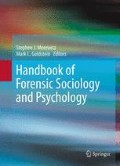Abstract
This chapter is an overview of the evaluation of child abuse and neglect for use in forensic settings. The topic of child abuse and neglect is relevant to numerous legal proceedings. They include criminal prosecution of perpetrators, contested child custody and visitation determinations, and civil liability. Two different components of evaluation are discussed: the determination of whether or not abuse or neglect has occurred, and the determination of the causality, or identification of a specific perpetrator. Various definitions of child abuse and neglect are discussed and contrasted as they differ from state to state in the USA. Federal efforts at definition are also discussed. Standards and guidelines for forensic evaluation of child abuse and neglect are also reviewed. Other responsibilities of examiners such as mandates for reporting child abuse to authorities and the need to protect the child from harmful aftereffects of the examination are also discussed. Specific procedures for the evaluation of suspected child abuse and neglect are reviewed and critiqued. These include methods of interviewing and observation as well as use of corroborating information. Relevant research is described and cited. Case studies are used to illustrate different applications of evaluation techniques that insure the validity and reliability of findings and safeguard the admissibility of findings. Topics related to courtroom testimony of forensic evaluators of child abuse and neglect are also discussed. These include admissibility of expert testimony as defined by Rule of Evidence 702 based on Frye and Daubert standards, which also vary from state to state.
Access this chapter
Tax calculation will be finalised at checkout
Purchases are for personal use only
References
ABCAN—U.S. Advisory Board on Child Abuse and Neglect. (1993). The continuing child protection emergency: a challenge to the nation.
American Academy of Child and Adolescent Psychiatry. (2010). Policy statement: Guidelines for the clinical evaluation for child and adolescent sexual abuse.
American Professional Society on the Abuse of Children (APSAC), (2002). Practice guidelines: Investigative interviewing in cases of alleged child abuse.
American Psychiatric Association. (2000). Diagnostic and Statistical Manual of Mental Disorders (4th Edn.): Text Revision (DSM-IV-TR). Arlington, VA: American Psychiatric Publishing, Inc.
Berliner, L., & Barbieri, M. K. (1984). The testimony of the child victim of sexual assault. Journal of Social Issues, 40(2), 125–137.
Cassel, W. S., Roebers, C. E. M., & Bjorklund, D. F. (1996). Developmental patterns of eyewitness responses to repeated and increasingly suggested questions. Journal of Experimental Child Psychology, 61, 116–133.
Child Welfare Information Gateway (CWIG). (2008). What is child abuse and neglect? (Fact Sheet). U.S. Government.
Ceci, S. J., & Huffman, M. C. (1997). How suggestible are preschool children? Cognitive and social factors. Journal of the American Academy of Child & Adolescent Psychiatry, 36(7), 948–958.
Eliott, D. M., & Briere, J. (1994). Forensic sexual abuse evaluation of older children: disclosures and symptomatology. Behavioral Sciences and the Law, 12, 261–277.
Flicker, B. D. (1982). Institute of judicial administration, American bar association, juvenile justice standards project, standards for juvenile justice: a summary and analysis (2nd ed.). Cambridge, MA: Ballinger Publishing Company.
Flin, R., Stevenson, Y., & Davies, G. M. (1989). Children’s knowledge of court proceedings. British Journal of Psychology, 80, 285–297.
Gardner, L. I. (1972). Deprivation dwarfism. Scientific American, 277, 76–82.
Goodman, G. S., & Quas, J. (2008). Repeated interviews in children’s memory. New Directions in Psychological Science, 17(6), 386–389.
Goodman, G., Quas, J., Batterman-Faunce, J., Riddlesberger, M., & Kuhn, J. (1994). Predictors of accurate and inaccurate memories of traumatic events experienced in childhood. In K. Pezdek & W. Banks (Eds.), False memory debate (pp. 3–28). San Diego, CA: Academic.
Goodman, G., Quas, J., Batterman-Faunce, J., Riddlesberger, M., & Kuhn, J. (1997). Children’s reactions to and memory for a stressful event: influences of age, anatomical dolls, knowledge, and parental attachment. Applied Developmental Science, 1, 54–75.
Harari, H., & McDavid, J. W. (1969). Situational influence on moral justice: a study of ‘finking. Journal of Personality and Social Psychology, 11, 240–244.
Janssen, M. R. (1984). Incest: exploitive child abuse. The Police Chief, 51, 46–7.
Melon, G. B., Petrila, J., Poythress, N. G., & Slobogin, C. (1997). Psychological evaluations for the courts: a handbook for mental health professionals and lawyers (2nd ed.). New York: Guilford Press.
Myers, J. E. B. (2010). The APSAC handbook on child maltreatment. Thousand Oaks, CA: Sage.
National Guideline Clearinghouse (NGC). (2007). Guideline: evaluation of suspected child physical abuse. U.S. Department of Health & Human Services.
National Resource Center on Child Sexual Abuse. (1992). www.prevent-abuse-now.com.
Pence, D. M. (2011). Child abuse and neglect investigation. In J. E. B. Myers (Ed.), The APSAC handbook on child maltreatment (3rd ed.). Thousand Oaks, CA: Sage.
Peters, D. P. (1991). The influence of stress and arousal on the child witness. In J. Doris (Ed.), The suggestibility of children’s recollections (pp. 60–76). Washington, DC: American Psychological Association.
Sorensen, T., & Snow, B. (1991). How children tell: the process of disclosure in child sexual abuse. Child Welfare League of America, 70, 3–15.
Tun, P., & Wingfield, A. (1993). Is speech special? Perception and recall of spoken language in complex environments. In J. Berella, J. Rybash, W. Hayer, & M. Commons (Eds.), Adult information processing: limits on loss (pp. 425–457). San Diego, CA: Academic.
U.S. Department of Health and Human Services; Administration for Children & Families. Child abuse prevention and treatment act, as amended (CAPTA) (Originally enacted in 1988, amended in 1989, 1996). Washington, D.C.
Author information
Authors and Affiliations
Editor information
Editors and Affiliations
Rights and permissions
Copyright information
© 2014 Springer Science+Business Media New York
About this chapter
Cite this chapter
Lobel, D.S. (2014). Forensic Evaluation of Child Abuse. In: Morewitz, S., Goldstein, M. (eds) Handbook of Forensic Sociology and Psychology. Springer, New York, NY. https://doi.org/10.1007/978-1-4614-7178-3_25
Download citation
DOI: https://doi.org/10.1007/978-1-4614-7178-3_25
Published:
Publisher Name: Springer, New York, NY
Print ISBN: 978-1-4614-7177-6
Online ISBN: 978-1-4614-7178-3
eBook Packages: Behavioral ScienceBehavioral Science and Psychology (R0)

